Director Visits CARD, CUP
Collins Applauds Extraordinary Efforts at Construction Site, Utility Plant
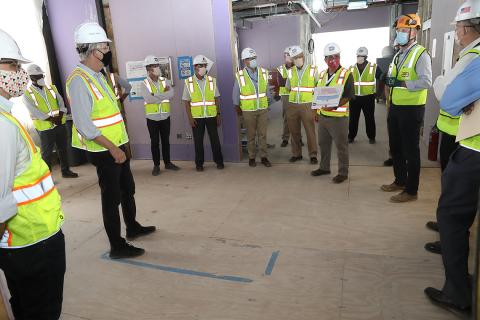
Photo: Chia-Chi Charlie Chang
“On time and on budget.” Five words that are music to heads of organizations everywhere probably sounded especially sweet to NIH director (and resident musician-in-chief) Dr. Francis Collins recently as he made another stop on his “Gratitude Tour.” He has visited several key staff and locations in 2021 to show his appreciation for employees and their continuous high-quality efforts in the midst of unprecedented, pandemic conditions.
On July 21, he took time to thank staff at two locations: the Center for Alzheimer’s and Related Dementias (CARD), one of the largest construction projects on the Bethesda campus; and the Central Utility Plant (CUP), the main source of power and utilities for NIH operations in Bethesda.
“This is my chance to say thank you,” Collins told the dozens of helmeted workers assembled outside the building going up on Service Rd. in the center of campus. “I know you have been working incredibly hard to support this project, to do something on a timetable that a lot of people said, ‘Oh that’s never going to work.’ But you’re meeting all these milestones and getting it done. What will go on in that building—as these remarkable scientists will tell you—will be major discoveries about Alzheimer’s disease and related disorders, which we’re all thinking about in terms of ourselves and our families. This is the right moment for this campus, with its incredible critical mass of scientists. So, please remember the big picture…What you’re doing is creating a new opportunity for one of the most pressing medical needs of our generation. Feel good about that. Even if you’re having a tough day.”
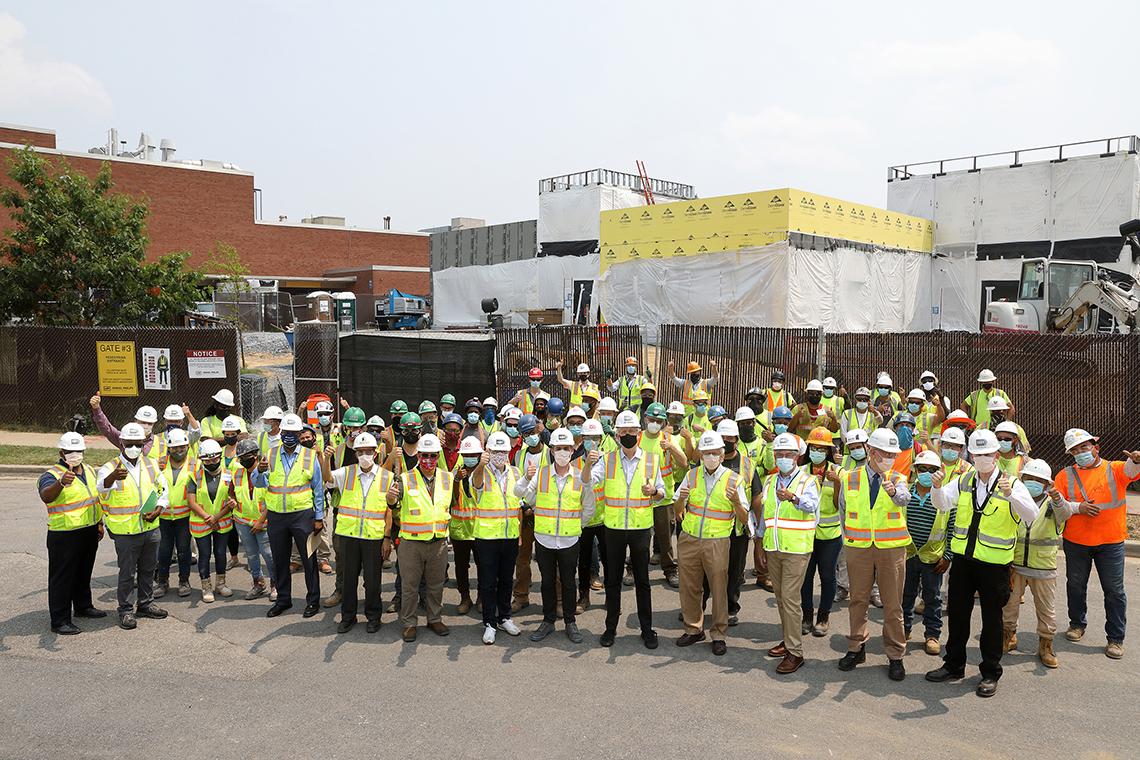
Photo: Chia-Chi Charlie Chang
CARD project officer Mitch Taragin then led Collins and several other top leaders on a tour of the 1.3-acre site that broke ground just before Labor Day 2020. The CARD, or Bldg. T-44, consists of individual modular units that were built at a factory in Leesburg, Fla., just outside Orlando. Modules were then shipped via truck to Bethesda for assembly. A 600-ton capacity crane set each unit in place.
“We are still on schedule and still on budget” despite unusual workplace conditions due to the pandemic, Taragin announced at the tour’s start. He has walked the job site every weekday since construction began.
A full-time federal employee since November 2019, Taragin has worked at NIH in some capacity since 2007. CARD marks his largest responsibility to date, managing some 70-plus onsite workers. In April, he traveled to Florida for several days to oversee the first units under construction.
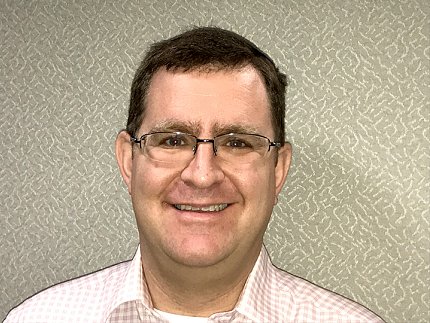
“CARD will be NIH’s most well-traveled building by far,” quipped Matt Frazier, project manager for general contractor Hensel Phelps. Frazier explained that collectively the modules will have logged some 155,000 highway miles making their way from Florida to Maryland.
Once completed—target date February 2022—the 24,000-plus sq. ft. CARD structure will consist of 65 units, with about 12,000 sq. ft. of lab space and 9,000 sq. ft. for office areas. Approximately 130 scientists and support personnel will occupy CARD, beginning in spring 2022.
“I find it so rewarding to work on campus,” Taragin said. “I look forward to coming to work every day and just knowing what our mission is, specifically for this project, which is helping to solve Alzheimer’s and dementia.”
After seeing CARD progress, Collins and company took a brief hike across Service Rd. to visit NIH’s CUP, one of the largest utility plants in the United States.
Dr. Farhad Memarzadeh, director of the Office of Research Facilities’ Division of Technical Resources (DTR) and a leading researcher in bioenvironmental studies, led a tour of what is essentially the campus’s nerve/circulatory system, the Central Utility Plant or CUP.
The CUP provides steam, chilled water and compressed air to the Bethesda campus, serving in excess of 12 million gross sq. ft. of clinical, research and administrative facilities, including the 240-bed hospital. The CUP is a critical facility for continuity of NIH operations.
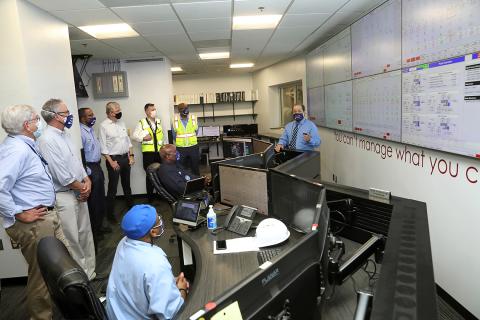
Photo: Chia-Chi Charlie Chang
Memarzadeh explained that the CUP collects more than 104 million live automated data points every day and conducts about a million advanced calculations during approximately 5,000 continuous analyses. Data is considered one of the most important commodities in CUP daily operation.
“Data is the currency and lifeline in a rapidly changing and technologically complex field,” he pointed out. “In the last several years, DTR introduced and used three powerful drivers–exponential data collection, sophisticated distributed networks and highly advanced mathematical algorithms–to advance and improve the NIH CUP, making it one of the most technologically advanced utility plants in the country.”
Since joining NIH in the early 1990s, Memarzadeh also has been a leading champion for energy conservation efforts and minimizing NIH’s ecological footprint. With one of the largest cogeneration plants in the federal government, NIH produces about 40 percent of the campus’s steam and electricity needs.
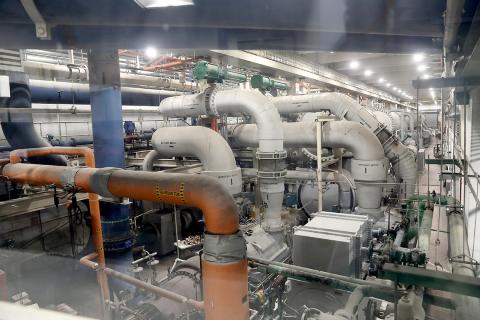
Photo: Chia-Chi Charlie Chang
Of necessity, the CUP must operate 24/7 with no breaks, regardless of external conditions. Memarzadeh reported continuous service by both staff and equipment, despite the ebb and flow of the campus population due to the pandemic telework situation. In addition, the CUP maintained its energy efficiency and saved NIH hundreds of thousands of dollars in utility costs.
“I had no idea what all was going on inside these walls,” Collins said, viewing images of the specially designed and uniquely modified combustion jet engine that powers NIH’s cogeneration plant. “The outside is not nearly as impressive as the inside.”
The touring group also got to see a simulated emergency, when operators launched an outage that monitors had to detect and address to prevent a serious utility shutdown.
Over the early days of the pandemic, before vaccine availability, the CUP was extra vigilant about preparing for potential emergencies or shortages in supplies as well as human resources.
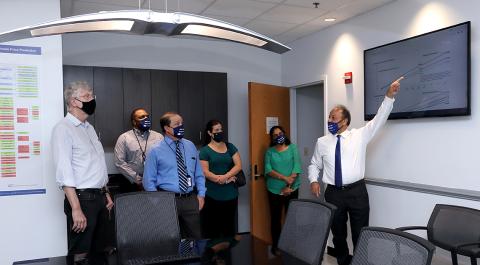
Photo: Chia-Chi Charlie Chang
“We just needed to make sure all the spare parts and the chemicals for the water treatment were available. because we didn’t know how the supply chain was going to be affected,” recalled Alamelu Ramesh, DTR deputy director. “But we had a plan. We always have a 3 months’ supply on hand, so that we will never run out of things. Then the big issue was we really hoped and prayed that our operators didn’t fall sick. We implemented all safety protocols, and we were very fortunate that everyone basically stayed healthy.”
Celebrating 15 years as an NIH’er, Ramesh remembers joining NIH in 2006 as an electrical engineer who designed buildings’ electrical systems for private consulting firms. Memarzadeh recruited her as his deputy, where she oversees six branches as well as budget and staffing.
“It’s absolutely fantastic,” she said. “It’s all because of Farhad that I’m here. People don’t know this about him, but he makes this all work. We are like one big family.”
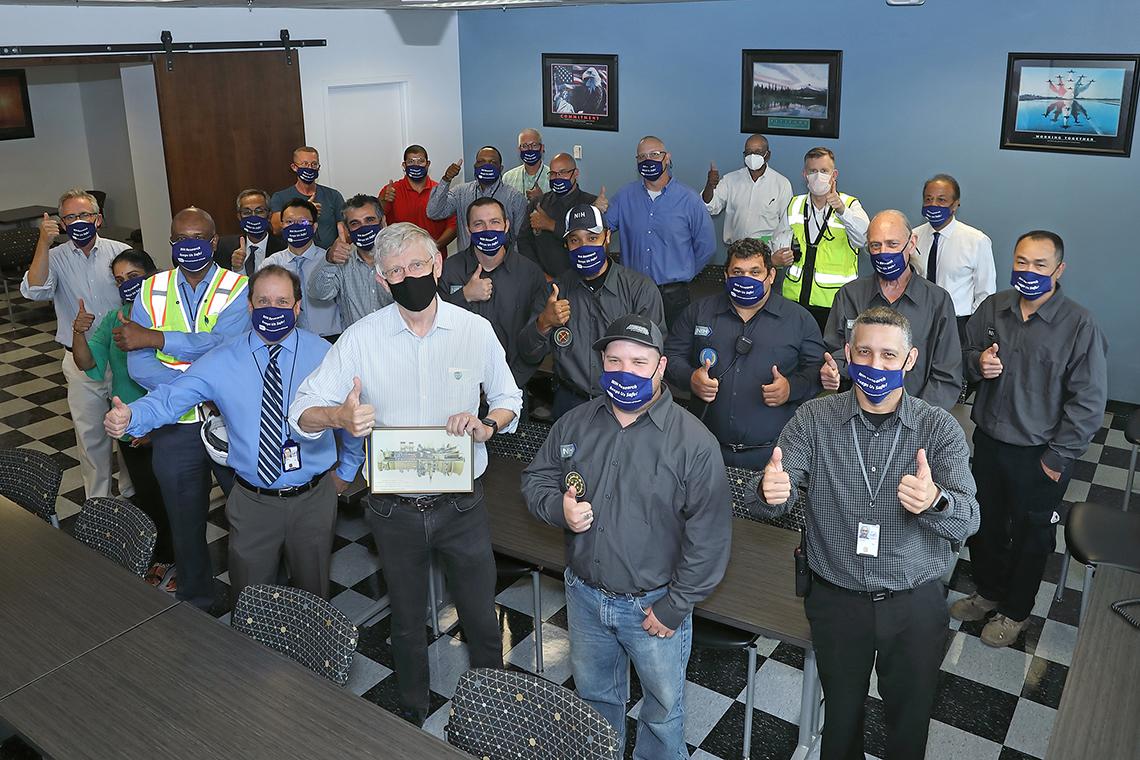
Photo: Chia-Chi Charlie Chang
